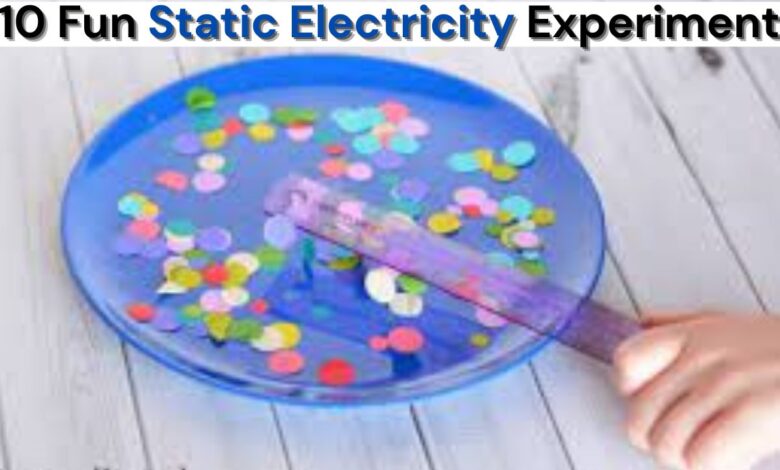10 Fun Static Electricity Experiment

Static electricity is the result of an imbalance of electrical charges on the surface of an object. Unlike current electricity, which flows in a continuous path, static electricity involves stationary charges that are created due to friction or separation.
Table of Contents
A Fascination with Electricity
From the crackling sound of a balloon rubbing against your hair to the mesmerizing dance of emitting objects, the fascination with static electricity extends beyond the science classroom. Let’s look at the science behind this fascinating phenomenon.
10 Fun Static Electricity Experiment
1. The Hair-Raising Balloon Challenge
Hair-Raising Balloon and watch your hair defy gravity! Discover the magic of this as the balloon builds up a charge, causing your hair to end. This experiment is not only visually impressive but also an excellent introduction to the world of static electricity.
2. Salt and Pepper Dance: An Electrostatic Ballet
Witness the mesmerizing Salt and Pepper Dance. Sprinkle a mixture of salt and pepper on a table, charge a balloon, and watch the particles move in a mesmerizing dance due to static electricity. It’s a simple yet fascinating experiment that brings science to life.
3. Static Electricity Bells: A Musical Charge
Turn it into music by building simple Static Electricity Bells. Learn how to use the power of charges to ring bells without touching them. It’s a delightful experiment that combines science and melody in a melodious symphony of static.
4. Floating Orb: Levitating static magic
Ever seen a Floating Orb mysteriously levitate? With this experiment, you’ll witness the fascination of static electricity in a small, lightweight room defying gravity. It’s an impressive visual display that adds an element of magic to your understanding of electrostatics.
5. Static Butterfly Wings: Artistic electric flutter
Transform ordinary paper butterflies into magical, fluttering creations. Charge them with static electricity, and watch them dance delicately in the air. This experiment not only demonstrates the whimsical side of static electricity but also offers a fun craft opportunity.
6. Electrifying Spoon Race: A static relay
Turn an ordinary race into an electrifying contest. Charge plastic spoons with it and watch them zoom across a surface, defying the normal laws of motion. This is a playful experiment that adds a jolt of excitement to the traditional spoon race
7. Still Water Bending: A Liquid Light Show
Experience the mesmerizing dance of water as the static electricity bends its way. This experiment demonstrates the effect of static charge on the behavior of water, creating an impressive liquid light display. It’s a visually stunning display that adds a touch of magic to your science explorations
8. Static Electricity Painting: Artistic Charge Unleashed
Combine science and art in this creative experiment. Use static electricity to guide paint on a canvas, creating unique and abstract masterpieces. This is a hands-on activity that lets you express your artistic side while exploring the principles of electrostatics.
9. The Glowing Neon Stick: Illuminated Science
Transform a regular neon stick into a brilliant spectacle with the power of static electricity This experiment investigates how charge can affect the luminescence of neon light, turning a simple stick into a brilliant display of scientific ingenuity.
10. Static Electricity in Nature: Discovering Electrical Phenomena
Experiment outside and explore the role of this nature. From rustling leaves to electrifying storms, uncover the many forms of static charge in the natural world. It is an interesting journey that connects experiments with real-life events
Conclusion
Static Electricity Experiments offers a thrilling journey into the fascinating world of static charge. From simple balloon attractions to advanced van de Graaff generator experiments, the possibilities are electrifying Embrace the joy of learning, inspire future scientists, and remember—science is not just a subject; It’s an adventure.
The Science Behind Static Electricity
Explanation of Electron
To understand this, one must understand the concept of electrons – tiny, negatively charged particles within atoms. When certain substances rub against each other, they either gain or lose electrons, creating an electrical charge.
Triboelectric Effect
The triboelectric effect, the primary mechanism behind this, occurs when materials gain or lose electrons through friction. This phenomenon is the driving force behind many of its experiments.
Conductors and Insulators
Materials can be classified as conductors or insulators based on their ability to carry electric charge. Understanding this classification is critical to successful static electricity testing.
Top 10 Best Telemarketing Dialer System in 2024
Simple Experiment
Balloon Attraction
Watch the magic of this as the balloon is attracted to hair or walls. This simple experiment is not only entertaining but also a great introduction to the world of static charge.
Salt and Pepper Separator
Explore the repulsion of it by separating salt and pepper using a charged object. This experiment demonstrates the electrostatic forces at play on a small scale.
Dancing Paper
Enjoy the joy of static-driven movement with the Dancing Paper Experiment. Discover how a statically charged object can make lightweight materials move and dance.
Intermediate Experiment
The Van de Graaf Generator is fun
Take your experiments to the next level with the Van de Graaff Generator. Witness hair-raising moments and understand the principles of charge storage in a controlled environment.
Static-powered Levitation
Defy gravity as you experiment with static-powered levitation. This intermediate-level experiment demonstrates interesting interactions between static charges and lightweight objects.
DIY Electroscope
Build your electroscope using common household items. This experiment allows you to visualize the presence of static charges and understand their behavior.
Safety Precautions
Handling Static Electricity
While experiments are fascinating, it is essential to conduct them with care Learn the necessary precautions to ensure a safe and enjoyable experience.
Protective Measures
Discover protective measures such as wearing an anti-static wristband to reduce the risk of electric shock during it experiments.
Applications of Static Electricity
Everyday Examples
From the crack of clothes in the dryer to the shock felt after ruffling a carpet, explore how it is present in everyday life.
Industrial Applications
Dive into the practical applications of static electricity in a variety of industries, including printing, painting, and dust control.
The Fun of Learning through Static Electricity
Educational standards
These experiments provide a hands-on approach to learning basic scientific principles. Engage in interactive learning that sparks curiosity and fosters a love of science.
Inspired future scientist
Reveal the potential of its experiments to inspire the next generation of scientists. Encourage curiosity and critical thinking with this engaging activity.
Top 10 Best Google Account Recovery Ideas
Frequently Asked Questions (FAQs) about
1. Is Static Electricity Dangerous?
Static electricity itself is not dangerous, but certain conditions and situations can cause electric shock. It is essential to follow safety precautions while conducting tests.
2. Can I try these tests at Home?
Absolutely! Most of the tests mentioned are safe to try at home with proper supervision and following safety guidelines.
3. What materials do I need for this Exam?
Many experiments require common household items such as balloons, paper, and salt. For advanced testing, consider getting a van de Graaff generator or an electroscope.
4. How do static electricity applications benefit industries?
Industries use static electricity for processes such as printing, painting, and dust control. Understanding static electricity helps improve efficiency and product quality.
5. Where can I find more resources about this?
Check out the recommended books, websites, and DIY kits mentioned in the article to delve deeper into the world of static electricity.







